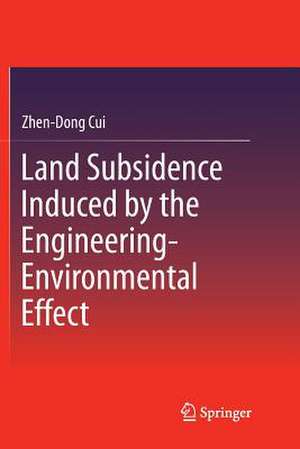Land Subsidence Induced by the Engineering-Environmental Effect
Autor Zhen-Dong Cuien Limba Engleză Paperback – 12 ian 2019
| Toate formatele și edițiile | Preț | Express |
|---|---|---|
| Paperback (1) | 638.57 lei 6-8 săpt. | |
| Springer Nature Singapore – 12 ian 2019 | 638.57 lei 6-8 săpt. | |
| Hardback (1) | 644.82 lei 6-8 săpt. | |
| Springer Nature Singapore – 8 feb 2018 | 644.82 lei 6-8 săpt. |
Preț: 638.57 lei
Preț vechi: 751.25 lei
-15% Nou
Puncte Express: 958
Preț estimativ în valută:
122.22€ • 127.12$ • 102.42£
122.22€ • 127.12$ • 102.42£
Carte tipărită la comandă
Livrare economică 14-28 martie
Preluare comenzi: 021 569.72.76
Specificații
ISBN-13: 9789811356933
ISBN-10: 9811356939
Ilustrații: XXII, 234 p. 164 illus., 129 illus. in color.
Dimensiuni: 155 x 235 mm
Greutate: 0.37 kg
Ediția:Softcover reprint of the original 1st ed. 2018
Editura: Springer Nature Singapore
Colecția Springer
Locul publicării:Singapore, Singapore
ISBN-10: 9811356939
Ilustrații: XXII, 234 p. 164 illus., 129 illus. in color.
Dimensiuni: 155 x 235 mm
Greutate: 0.37 kg
Ediția:Softcover reprint of the original 1st ed. 2018
Editura: Springer Nature Singapore
Colecția Springer
Locul publicării:Singapore, Singapore
Cuprins
Introduction.- Theoretical Analysis of Land Subsidence Caused by Engineering-Environmental Effect.- In-Site Monitoring Land Subsidence.- Centrifuge Modeling of Land Subsidence Caused by High-Rise Building Group.- Microstructures of Different Soil Layers Before and After Centrifuge Modeling of Land Subsidence Caused by High-Rise Building Group.- Microstructures of the Soil Layer at Different Depths in the Centrifuge Modeling of Land Subsidence Caused by the Interaction of Two High-Rise Buildings.- Physical Model Test of Layered Soil Subsidence Considering Dual Effects of Building Load and Groundwater Withdrawal.- Floor Area Ratio ANFIS Model Affected by Causes of Land Subsidence.- Conclusions and Prospects.
Notă biografică
Professor Zhendong Cui received his Ph.D. Degree from the School of Civil Engineering, Tongji University in 2008. He worked as a postdoctoral research fellow for one year at the Hong Kong University of Science and Technology. He currently works as a professor in the School of Mechanics and Civil Engineering at the China University of Mining and Technology (CUMT). He is also a visiting scholar at the University of Colorado Boulder from 2015 to 2016. He has published 34 SCI indexed papers in many international journals.
Textul de pe ultima copertă
This book brings forward the concept of the geology-environmental capacity of ground buildings. It quantifies the geology-environmental capacity of ground buildings by analyzing the main factors of land subsidence and setting up the evaluation system. The geological environmental capacity of ground buildings is mainly controlled by the land subsidence and the output is the floor area ratio. According to the different geology structures and the different requirements of subsidence control in the soft soil areas in Shanghai, the evaluation system of the floor area ratio is built up by the adaptive neuro-fuzzy inference system (ANFIS) and the floor area ratios of four typical regions (Lujiazui, Xujiahui, Zhongyuan and Changqiao) are obtained by the ANFIS to offer references for urban planning. By taking the typical soft soil areas in Shanghai as case studies, this book will provide valuable insights to professors and graduate students in the field of Geotechnical Engineering, Civil Engineering, Engineering Geology and Environmental Geology.
Caracteristici
Studies land subsidence caused by the dual effects of building load and groundwater withdrawal Presents rich research methods including the centrifuge model, the physical model, in-site monitoring, the MIP test, the SEM test, the ANFIS model, the GM (1,1) model, the numerical simulation and theoretical analysis Uses PIV techniques to measure the deformation of the soil layer
